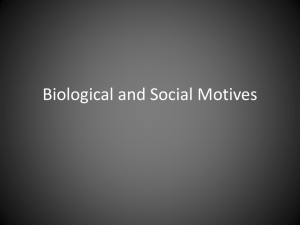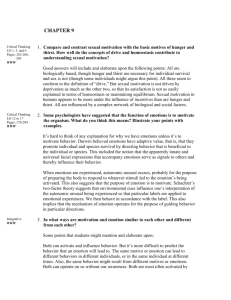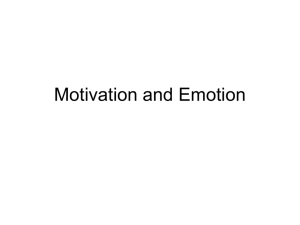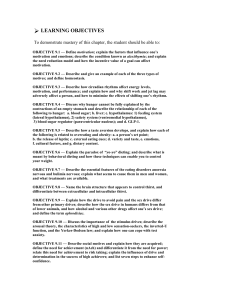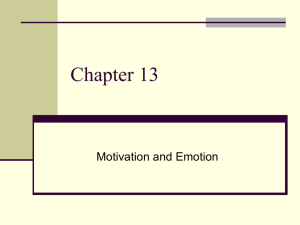CHAPTER 11 – MOTIVATION & EMOTION
advertisement
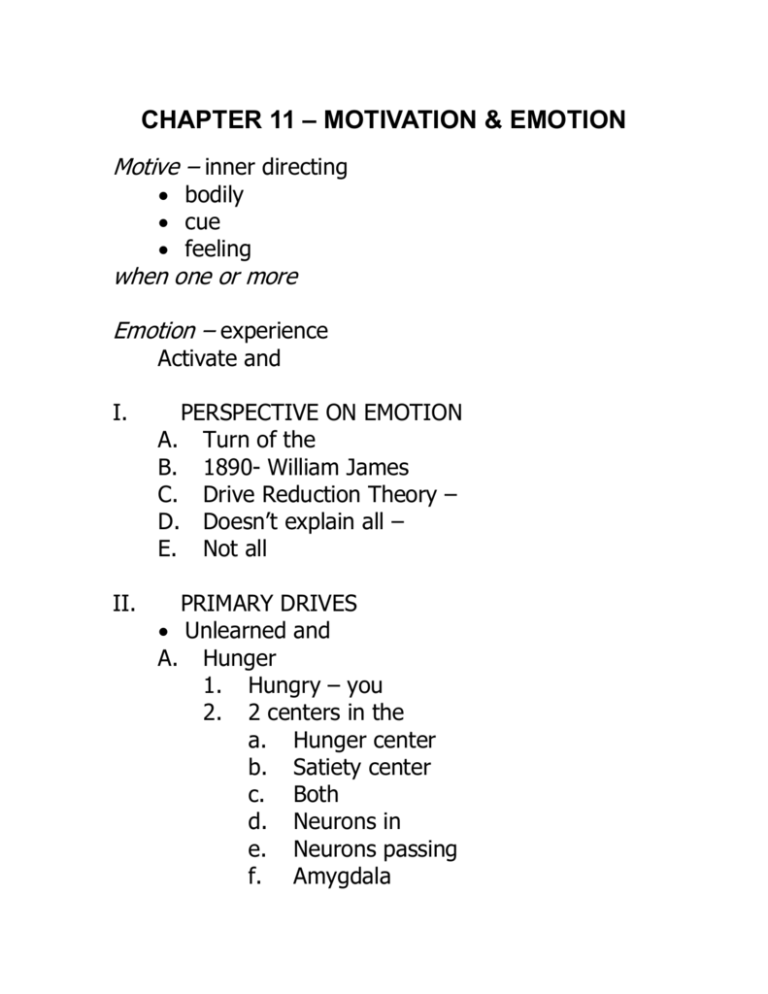
CHAPTER 11 – MOTIVATION & EMOTION Motive – inner directing bodily cue feeling when one or more Emotion – experience Activate and I. PERSPECTIVE ON EMOTION A. Turn of the B. 1890- William James C. Drive Reduction Theory – D. Doesn’t explain all – E. Not all II. PRIMARY DRIVES Unlearned and A. Hunger 1. Hungry – you 2. 2 centers in the a. Hunger center b. Satiety center c. Both d. Neurons in e. Neurons passing f. Amygdala B. C. 3. Brain monitors 4. Increase level of 5. Brain monitors amounts and 6. Some evidence 7. Another regulator 8. With exception 9. External cues 10. Rodin (1985) – such external cues 11. Hunger drive 12. Social influences 13. Way respond Thirst 1. Controlled by 2 2. Salt – water leaves 3. Don’t fully 4. Outside cells – 5. 2 regulators 6. Although primary drive – Sex Can be Humans are Experience shapes Not vital to 1. Biological factors in arousal a. Powerfully affected b. Testosterone – c. May be affected by d. Nervous system e. Brain exerts 2. a. b. c. d. III. Psychological influences on sexual motivation Humans motivated Number of stimuli Gender differences 1) Men more 2) Women more Also differences STIMULUS MOTIVES Largely unlearned Main function Activity, curiosity, A. Activity 1. People need 2. Age, sex 3. Not sure if B. Exploration and curiosity 1. Activated by new 2. Even animals 3. Animals seem 4. Are reservations – 5. As learn and C. Manipulation 1. Directed toward 2. Seems be 3. Related to a. Need to b. Need to 4. Brighter the object, D. Contact 1. Want to 2. Broader and 3. Not limited 4. Contact can 5. Harlow 1958; Harlow & Zimmerman 1959 IV. LEARNED MOTIVES – SOCIAL MOTIVES center of relationships as grow governed A. Aggression 1. All behavior 2. Judging from crime 3. Why so a. Part of b. In response 4. Frustration generates 5. Aggression may 6. Freud – aggression 7. One important 8. Today feel is 9. Seeing aggressive model 10. Aggression can be B. Achievement 1. Interest in 2. Need for 3. 3 separate but interrelated aspects V. a. Work orientation b. Mastery c. Competitiveness 4. Helmreich & Spence – high degree a. highly competitive b. preoccupation with c. overwhelming need to 5. General traits of those high in need a. Fast b. Driven need c. Energetic and few d. Tense and C. Power 1. Need win 2. Like achievement 3. Winter (1976) – interesting relationship a. President when country b. Power motive scores c. President with higher D. Affiliation 1. Need to be with 2. Aroused when 3. May result from 4. Fear and 5. Schachter – one reason 6. Rofe (1984) – people seek 7. Affiliation behavior HIERARCHY OF MOTIVES A. B. C. D. VI. Maslow arranged Higher motives Maslow – Criticisms – a. Based primarily on b. Useful way to EMOTIONS like motives can can classify according to *approach in *avoid *approach in emotions can begin Yerkes-Dodson Law – more complex the task A. Basic Emotional Experiences – Plutchik – 1980 1. Plutchik – all “animals” have 8 2. Each helps us 3. Different emotions can 4. Variety levels 5. In general the more B. Theories of Emotions 1. James-Lange Theory – stimuli cause 2. Emotion simply aware of 3. Facial expressions can 4. Most physiological “signs” 5. Cannon-Bard Theory – emotions and 6. Cognitive Psychology – what you 7. 8. VII. Pennebaker & Skelton (1981) – 2 part process *respond with *then search *more attention Critics *reject idea *Zajnoc-affective system *Izard – babies born THE EXPRESSION OF EMOTION A. Verbal Communication 1. Many reasons 2. Sometimes diminish B. Nonverbal Communication 1. Transmit good deal 2. Facial expressions most 3. Many facial expressions innate 4. Charles Darwin – most animals 5. Some emotions 6. Body language 7. Birdwhistell 1952 – Kinesics 8. Can contradict 9. Rosenthall (1974,1979) – Profile of Nonverbal Sensitivity (PONS) – 10. Women consistently better than 11. Sensitivity to 12. Empathy – closely related to 13. Distance – culturally 14. Explicit Acts – 15. False cues VIII. GENDER DIFFERENCES AND EMOTION A. Males and females B. Men just as C. Some circumstances D. When men angered E. Women more F. Men 4 times more





